Tuesday 23rd June 2020
Archivist reveals history of Stamford School Chapel

Stamford Endowed Schools' Archivist, Mr James Buckman, has revealed the history of the historic Chapel at Stamford School.
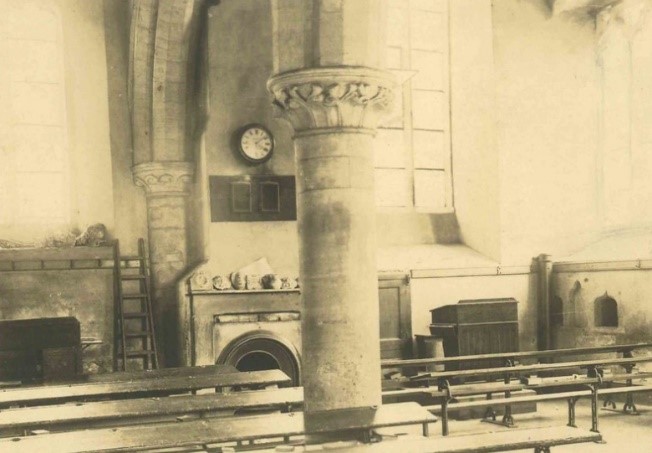 The two photographs above are the earliest known pictures of the Chapel building when it was the schoolroom. The boys arrived for lessons, kissed the Old Man above the door on the west wall, and passed through the door thus submitting themselves ‘to the discipline of learning’.On Speech Day, 1919, the then-headmaster, Canon Day, announced that this old schoolroom would be restored to its original purpose as a place of worship. The new chapel would serve as a memorial, not only for the assistant masters and Old Stamfordians who lost their lives in the First World War, but for those who had distinguished themselves and brought honour to the School.Canon Day formed a committee to oversee the conversion of the old schoolroom. Another of his first moves was to assign former pupil, Harvey Traylen (OS 1884-91) as the architect to this project. But then came the cost: the total estimate cost of the chapel was £2,000 (£103,949 in today’s money).The School adopted a variety of means to raise this money. On 7 July 1920, Stamford School ‘embarked upon its first dramatic venture for some considerable time'. A group of men and women (pictured below) associated with the Stamford School Dramatic Society gave a performance of His Excellency the Governor, ‘a farcical romance’ by Robert Marshall. The proceeds of the performance amounted to over £50. In total, the original appeal raised more than £600, but by the end of 1921, construction work still had yet to begin.
The two photographs above are the earliest known pictures of the Chapel building when it was the schoolroom. The boys arrived for lessons, kissed the Old Man above the door on the west wall, and passed through the door thus submitting themselves ‘to the discipline of learning’.On Speech Day, 1919, the then-headmaster, Canon Day, announced that this old schoolroom would be restored to its original purpose as a place of worship. The new chapel would serve as a memorial, not only for the assistant masters and Old Stamfordians who lost their lives in the First World War, but for those who had distinguished themselves and brought honour to the School.Canon Day formed a committee to oversee the conversion of the old schoolroom. Another of his first moves was to assign former pupil, Harvey Traylen (OS 1884-91) as the architect to this project. But then came the cost: the total estimate cost of the chapel was £2,000 (£103,949 in today’s money).The School adopted a variety of means to raise this money. On 7 July 1920, Stamford School ‘embarked upon its first dramatic venture for some considerable time'. A group of men and women (pictured below) associated with the Stamford School Dramatic Society gave a performance of His Excellency the Governor, ‘a farcical romance’ by Robert Marshall. The proceeds of the performance amounted to over £50. In total, the original appeal raised more than £600, but by the end of 1921, construction work still had yet to begin.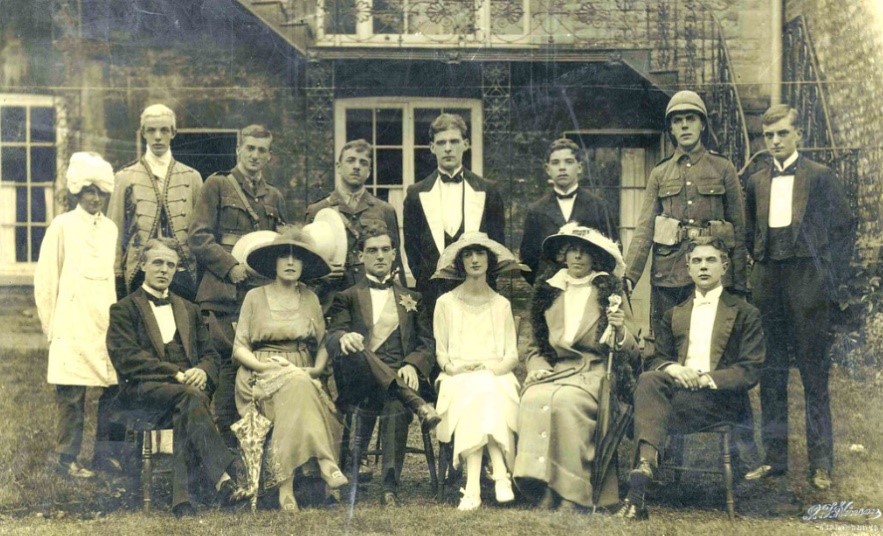 By 1920, there were 200 boys attending Stamford School. As time went by, the student body grew constantly. The old schoolroom was still needed to accommodate classes. In 1929, the Board of Governors purchased Brazenose House just across the road. Not long afterwards, Northfields House, the former home of Orlando Edmonds (OS 1846-50) came on the market and was quickly secured by the School during the holidays. The extra classroom space meant the chapel project could finally begin. The committee was reconstituted at School House under the chairmanship of Col. L.H.P. Hart (OS 1896-9).As soon as the Summer Term of 1929 concluded, Harvey Traylen arrived along with the building contractors. Their first step was to demolish the west wall and lay the foundations for the building to be extended westward by almost thirty feet. ‘As the walls rose it took a new shape, a new beauty of proportion was revealed’.
By 1920, there were 200 boys attending Stamford School. As time went by, the student body grew constantly. The old schoolroom was still needed to accommodate classes. In 1929, the Board of Governors purchased Brazenose House just across the road. Not long afterwards, Northfields House, the former home of Orlando Edmonds (OS 1846-50) came on the market and was quickly secured by the School during the holidays. The extra classroom space meant the chapel project could finally begin. The committee was reconstituted at School House under the chairmanship of Col. L.H.P. Hart (OS 1896-9).As soon as the Summer Term of 1929 concluded, Harvey Traylen arrived along with the building contractors. Their first step was to demolish the west wall and lay the foundations for the building to be extended westward by almost thirty feet. ‘As the walls rose it took a new shape, a new beauty of proportion was revealed’.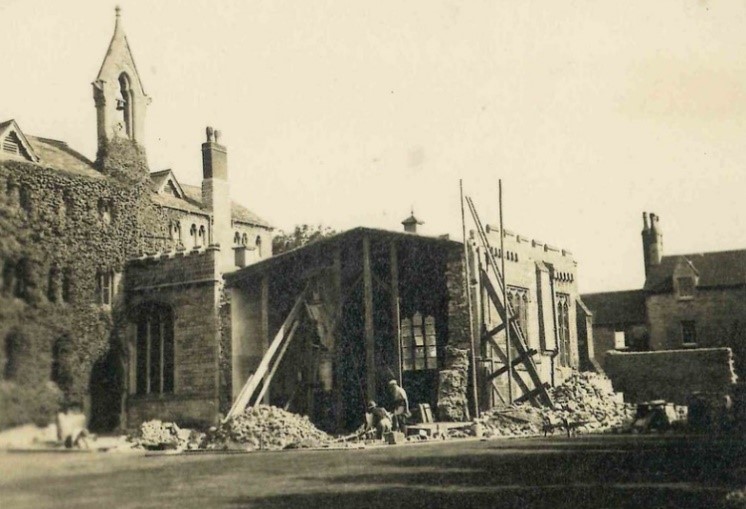
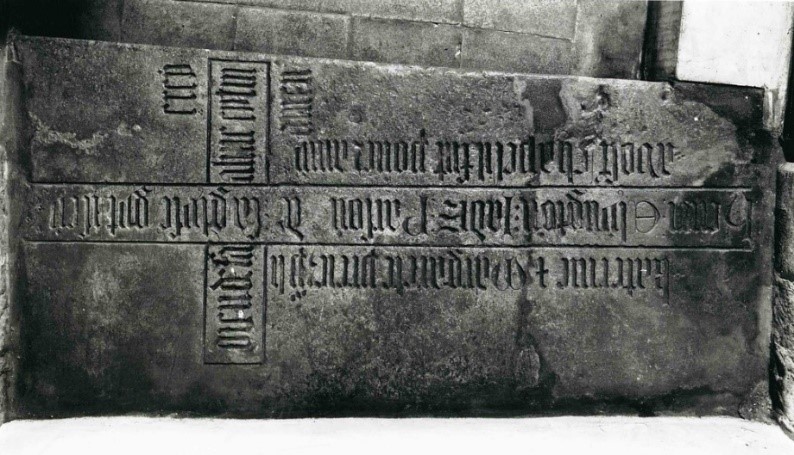
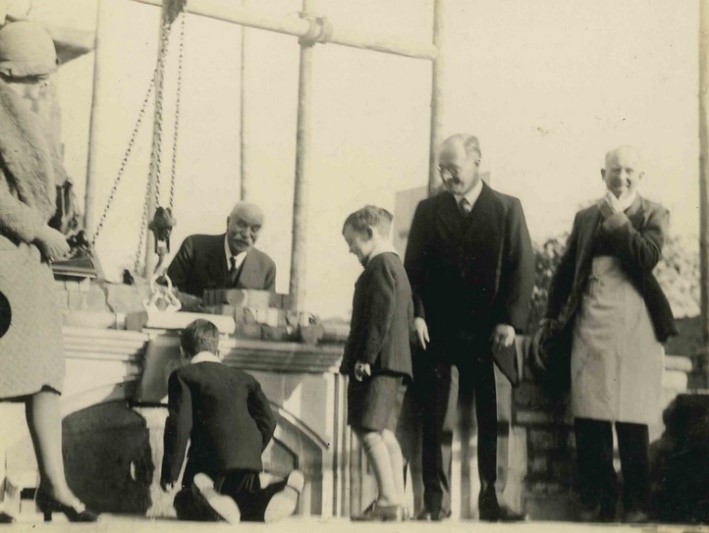 The Old Stamfordians Club initiated annual balls in aid of the Chapel Fund. The first occasion was attended by nearly 150 people, and raised £55 to supplement the Fund. The second ball had more attendees, but owing to heavier expenses ‘the nett proceeds were lower than before’ with only £35 raised towards the Chapel Fund. In addition to these subscriptions, the School were gifted with many items for the Chapel.These gifts included a seat from Colonel Hart, an alms dish from A.E. Dolby (OS 1886-8), a vestry table from F.J. Cummins (OS 1907-14), a lectern bible from the British and Foreign Bible Society, and an altar table and frontal from the Governors of the Browne’s Hospital. Old Boys as far back as the Rev. Mr Gretton’s headmastership, such as G.H. Burton (OS 1853-7), took great interest in this project. The Rev. Thomas Nevinson (OS 1861-70) visited Stamford often and checked in on progress with the Chapel. Sadly, he passed away months before Consecration Day.
The Old Stamfordians Club initiated annual balls in aid of the Chapel Fund. The first occasion was attended by nearly 150 people, and raised £55 to supplement the Fund. The second ball had more attendees, but owing to heavier expenses ‘the nett proceeds were lower than before’ with only £35 raised towards the Chapel Fund. In addition to these subscriptions, the School were gifted with many items for the Chapel.These gifts included a seat from Colonel Hart, an alms dish from A.E. Dolby (OS 1886-8), a vestry table from F.J. Cummins (OS 1907-14), a lectern bible from the British and Foreign Bible Society, and an altar table and frontal from the Governors of the Browne’s Hospital. Old Boys as far back as the Rev. Mr Gretton’s headmastership, such as G.H. Burton (OS 1853-7), took great interest in this project. The Rev. Thomas Nevinson (OS 1861-70) visited Stamford often and checked in on progress with the Chapel. Sadly, he passed away months before Consecration Day.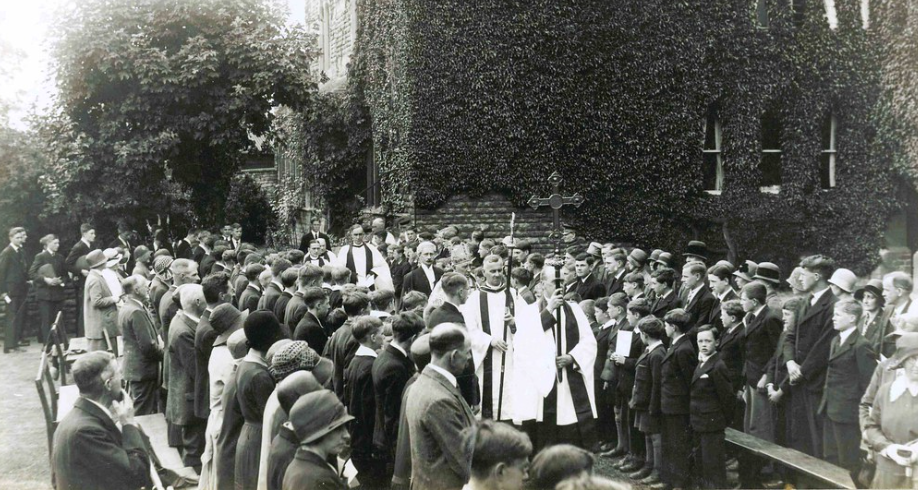 After ten months of construction work, the Chapel was consecrated on Saturday 21 June 1930. A large congregation of former and current pupils, and parents assembled both in the Chapel and on the lawn outside. Dr W.S. Swayne, the Bishop of Lincoln, was received at the west door by Canon Day, the Governors, the Assistant Masters and the Prefects where the Vice-Chairman read a petition praying the Bishop to consecrate the Chapel. The Bishop gave a few preliminary prayers, then took up his pastoral staff and knocked on the door three times. It was opened by Harvey Traylen and the procession entered the Chapel. The Bishop pronounced this sentence of consecration:“In the faith of Jesus Christ, and in memory of all who from this School gave their lives in the Great War, we consecrate and set apart this place under the name of the Chapel of Stamford School, for the worship of Almighty God; for the celebration of the Holy Sacraments; and for the preaching of God’s word; in the name of the Father, the Son, and the Holy Ghost. Amen.”At the Old Stamfordians’ Dinner, Charles Traylen (OS 1884-92), Harvey’s brother, said “I have nothing but admiration for my brother for his wonderful and tremendous skill and enthusiasm in carrying out that work. It is simply magnificent. It is a wonderful and lasting tribute to this great school”.
After ten months of construction work, the Chapel was consecrated on Saturday 21 June 1930. A large congregation of former and current pupils, and parents assembled both in the Chapel and on the lawn outside. Dr W.S. Swayne, the Bishop of Lincoln, was received at the west door by Canon Day, the Governors, the Assistant Masters and the Prefects where the Vice-Chairman read a petition praying the Bishop to consecrate the Chapel. The Bishop gave a few preliminary prayers, then took up his pastoral staff and knocked on the door three times. It was opened by Harvey Traylen and the procession entered the Chapel. The Bishop pronounced this sentence of consecration:“In the faith of Jesus Christ, and in memory of all who from this School gave their lives in the Great War, we consecrate and set apart this place under the name of the Chapel of Stamford School, for the worship of Almighty God; for the celebration of the Holy Sacraments; and for the preaching of God’s word; in the name of the Father, the Son, and the Holy Ghost. Amen.”At the Old Stamfordians’ Dinner, Charles Traylen (OS 1884-92), Harvey’s brother, said “I have nothing but admiration for my brother for his wonderful and tremendous skill and enthusiasm in carrying out that work. It is simply magnificent. It is a wonderful and lasting tribute to this great school”.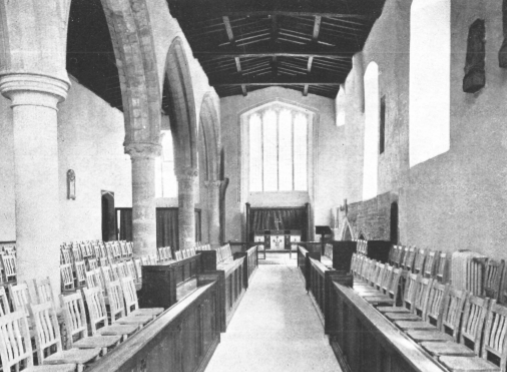 Explore the digital archives for yourself here, or read more stories from our Archivist, here.
Explore the digital archives for yourself here, or read more stories from our Archivist, here.
Origins
The Chapel is the oldest part of Stamford School. Originally part of St Paul’s Church, it is recorded in the Domesday Book of 1086, and is referred to in a deed dated 17 February 1200. It is also rumoured to have once been the meeting place for the Guild of St Katherine.In 1532, Alderman William Radcliffe died childless. In his will, he left his fortunes to endow a Grammar School in Stamford. St Paul’s Church was taken over to serve as a home for the new establishment. It served as a schoolroom for four hundred years.
 The two photographs above are the earliest known pictures of the Chapel building when it was the schoolroom. The boys arrived for lessons, kissed the Old Man above the door on the west wall, and passed through the door thus submitting themselves ‘to the discipline of learning’.On Speech Day, 1919, the then-headmaster, Canon Day, announced that this old schoolroom would be restored to its original purpose as a place of worship. The new chapel would serve as a memorial, not only for the assistant masters and Old Stamfordians who lost their lives in the First World War, but for those who had distinguished themselves and brought honour to the School.Canon Day formed a committee to oversee the conversion of the old schoolroom. Another of his first moves was to assign former pupil, Harvey Traylen (OS 1884-91) as the architect to this project. But then came the cost: the total estimate cost of the chapel was £2,000 (£103,949 in today’s money).The School adopted a variety of means to raise this money. On 7 July 1920, Stamford School ‘embarked upon its first dramatic venture for some considerable time'. A group of men and women (pictured below) associated with the Stamford School Dramatic Society gave a performance of His Excellency the Governor, ‘a farcical romance’ by Robert Marshall. The proceeds of the performance amounted to over £50. In total, the original appeal raised more than £600, but by the end of 1921, construction work still had yet to begin.
The two photographs above are the earliest known pictures of the Chapel building when it was the schoolroom. The boys arrived for lessons, kissed the Old Man above the door on the west wall, and passed through the door thus submitting themselves ‘to the discipline of learning’.On Speech Day, 1919, the then-headmaster, Canon Day, announced that this old schoolroom would be restored to its original purpose as a place of worship. The new chapel would serve as a memorial, not only for the assistant masters and Old Stamfordians who lost their lives in the First World War, but for those who had distinguished themselves and brought honour to the School.Canon Day formed a committee to oversee the conversion of the old schoolroom. Another of his first moves was to assign former pupil, Harvey Traylen (OS 1884-91) as the architect to this project. But then came the cost: the total estimate cost of the chapel was £2,000 (£103,949 in today’s money).The School adopted a variety of means to raise this money. On 7 July 1920, Stamford School ‘embarked upon its first dramatic venture for some considerable time'. A group of men and women (pictured below) associated with the Stamford School Dramatic Society gave a performance of His Excellency the Governor, ‘a farcical romance’ by Robert Marshall. The proceeds of the performance amounted to over £50. In total, the original appeal raised more than £600, but by the end of 1921, construction work still had yet to begin. By 1920, there were 200 boys attending Stamford School. As time went by, the student body grew constantly. The old schoolroom was still needed to accommodate classes. In 1929, the Board of Governors purchased Brazenose House just across the road. Not long afterwards, Northfields House, the former home of Orlando Edmonds (OS 1846-50) came on the market and was quickly secured by the School during the holidays. The extra classroom space meant the chapel project could finally begin. The committee was reconstituted at School House under the chairmanship of Col. L.H.P. Hart (OS 1896-9).As soon as the Summer Term of 1929 concluded, Harvey Traylen arrived along with the building contractors. Their first step was to demolish the west wall and lay the foundations for the building to be extended westward by almost thirty feet. ‘As the walls rose it took a new shape, a new beauty of proportion was revealed’.
By 1920, there were 200 boys attending Stamford School. As time went by, the student body grew constantly. The old schoolroom was still needed to accommodate classes. In 1929, the Board of Governors purchased Brazenose House just across the road. Not long afterwards, Northfields House, the former home of Orlando Edmonds (OS 1846-50) came on the market and was quickly secured by the School during the holidays. The extra classroom space meant the chapel project could finally begin. The committee was reconstituted at School House under the chairmanship of Col. L.H.P. Hart (OS 1896-9).As soon as the Summer Term of 1929 concluded, Harvey Traylen arrived along with the building contractors. Their first step was to demolish the west wall and lay the foundations for the building to be extended westward by almost thirty feet. ‘As the walls rose it took a new shape, a new beauty of proportion was revealed’.
Discoveries
As their work progressed, the workers kept on making thrilling discoveries. On the east side, they came across the remains of an old fireplace. Beneath the foundations, they found pieces of two sculptured figures clad in flowing robes, a carved statue head of Jesus Christ, several ancient coins, and some old bones which had long been buried there. ‘Soon young amateur archaeologists appeared, and with spade and sieve searched all the soil for treasure, and not in vain’. They came across pieces of glass, further coins and tokens, nails, clay pipes and slate pencils. The greatest discovery was made in November 1929.Thirty years previously, J.D. Barnard (OS 1895-1904, and son of the then-Headmaster, D.J.J. Barnard) had dug along the south side and came across this stone bearing a cross and some words. He could not read it in full because the side posts of the door covered some of the text. In 1929, the stone was extracted. This time, they established it to be a tombstone (pictured below) ‘some six feet in length’; that of Henri Elyngton, formerly Rector of St Paul’s Church. He was appointed to the position on 30 June 1384.
Final Preparations
On 17 October 1929, Lady Burghley had the honour of placing the Old Man above the new west door. The photograph below depicts John H. Jones (OS 1929-37), the youngest boarder, kissing the Old Man. Martin Staveley (OS 1929-40), the youngest day pupil (and younger brother of future Headmaster, H.A. Staveley) waits his turn. Lady Burghley and Mr Traylen watch. The Old Stamfordians Club initiated annual balls in aid of the Chapel Fund. The first occasion was attended by nearly 150 people, and raised £55 to supplement the Fund. The second ball had more attendees, but owing to heavier expenses ‘the nett proceeds were lower than before’ with only £35 raised towards the Chapel Fund. In addition to these subscriptions, the School were gifted with many items for the Chapel.These gifts included a seat from Colonel Hart, an alms dish from A.E. Dolby (OS 1886-8), a vestry table from F.J. Cummins (OS 1907-14), a lectern bible from the British and Foreign Bible Society, and an altar table and frontal from the Governors of the Browne’s Hospital. Old Boys as far back as the Rev. Mr Gretton’s headmastership, such as G.H. Burton (OS 1853-7), took great interest in this project. The Rev. Thomas Nevinson (OS 1861-70) visited Stamford often and checked in on progress with the Chapel. Sadly, he passed away months before Consecration Day.
The Old Stamfordians Club initiated annual balls in aid of the Chapel Fund. The first occasion was attended by nearly 150 people, and raised £55 to supplement the Fund. The second ball had more attendees, but owing to heavier expenses ‘the nett proceeds were lower than before’ with only £35 raised towards the Chapel Fund. In addition to these subscriptions, the School were gifted with many items for the Chapel.These gifts included a seat from Colonel Hart, an alms dish from A.E. Dolby (OS 1886-8), a vestry table from F.J. Cummins (OS 1907-14), a lectern bible from the British and Foreign Bible Society, and an altar table and frontal from the Governors of the Browne’s Hospital. Old Boys as far back as the Rev. Mr Gretton’s headmastership, such as G.H. Burton (OS 1853-7), took great interest in this project. The Rev. Thomas Nevinson (OS 1861-70) visited Stamford often and checked in on progress with the Chapel. Sadly, he passed away months before Consecration Day.Consecration Day
 After ten months of construction work, the Chapel was consecrated on Saturday 21 June 1930. A large congregation of former and current pupils, and parents assembled both in the Chapel and on the lawn outside. Dr W.S. Swayne, the Bishop of Lincoln, was received at the west door by Canon Day, the Governors, the Assistant Masters and the Prefects where the Vice-Chairman read a petition praying the Bishop to consecrate the Chapel. The Bishop gave a few preliminary prayers, then took up his pastoral staff and knocked on the door three times. It was opened by Harvey Traylen and the procession entered the Chapel. The Bishop pronounced this sentence of consecration:“In the faith of Jesus Christ, and in memory of all who from this School gave their lives in the Great War, we consecrate and set apart this place under the name of the Chapel of Stamford School, for the worship of Almighty God; for the celebration of the Holy Sacraments; and for the preaching of God’s word; in the name of the Father, the Son, and the Holy Ghost. Amen.”At the Old Stamfordians’ Dinner, Charles Traylen (OS 1884-92), Harvey’s brother, said “I have nothing but admiration for my brother for his wonderful and tremendous skill and enthusiasm in carrying out that work. It is simply magnificent. It is a wonderful and lasting tribute to this great school”.
After ten months of construction work, the Chapel was consecrated on Saturday 21 June 1930. A large congregation of former and current pupils, and parents assembled both in the Chapel and on the lawn outside. Dr W.S. Swayne, the Bishop of Lincoln, was received at the west door by Canon Day, the Governors, the Assistant Masters and the Prefects where the Vice-Chairman read a petition praying the Bishop to consecrate the Chapel. The Bishop gave a few preliminary prayers, then took up his pastoral staff and knocked on the door three times. It was opened by Harvey Traylen and the procession entered the Chapel. The Bishop pronounced this sentence of consecration:“In the faith of Jesus Christ, and in memory of all who from this School gave their lives in the Great War, we consecrate and set apart this place under the name of the Chapel of Stamford School, for the worship of Almighty God; for the celebration of the Holy Sacraments; and for the preaching of God’s word; in the name of the Father, the Son, and the Holy Ghost. Amen.”At the Old Stamfordians’ Dinner, Charles Traylen (OS 1884-92), Harvey’s brother, said “I have nothing but admiration for my brother for his wonderful and tremendous skill and enthusiasm in carrying out that work. It is simply magnificent. It is a wonderful and lasting tribute to this great school”. Explore the digital archives for yourself here, or read more stories from our Archivist, here.
Explore the digital archives for yourself here, or read more stories from our Archivist, here.